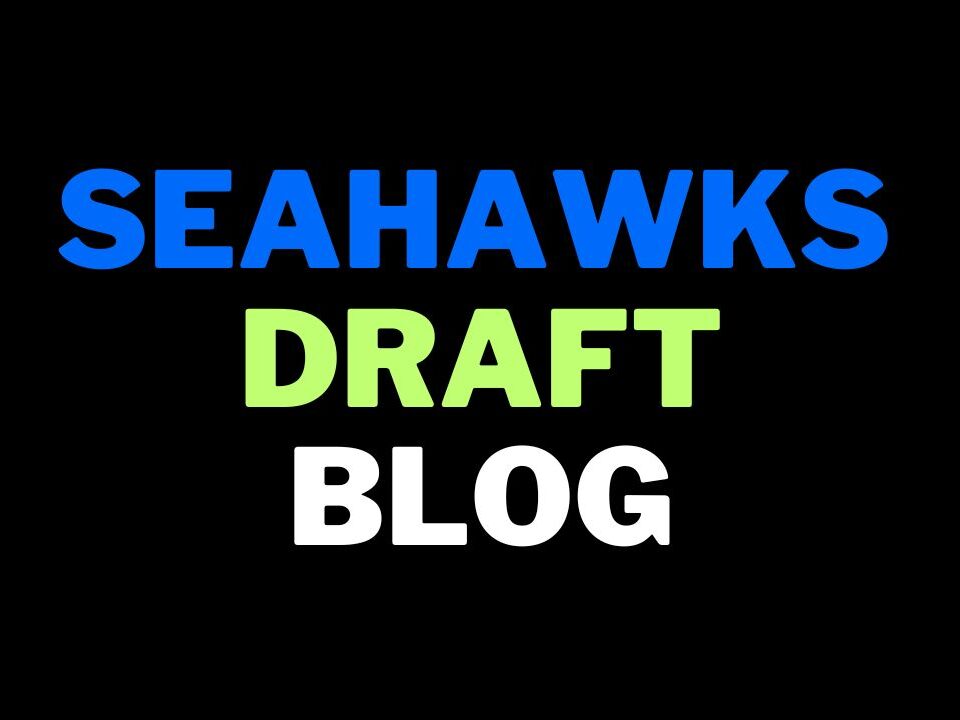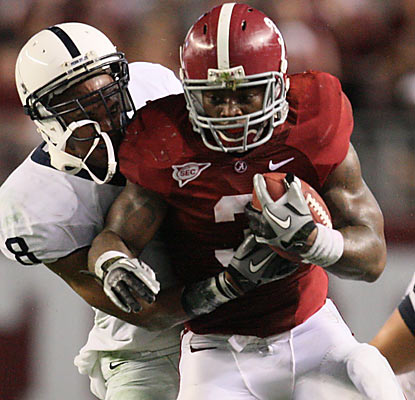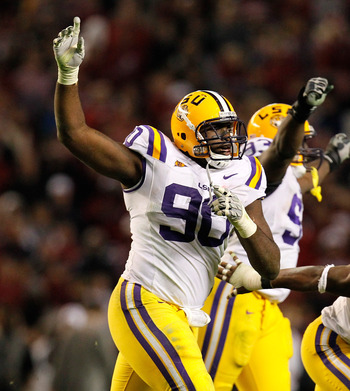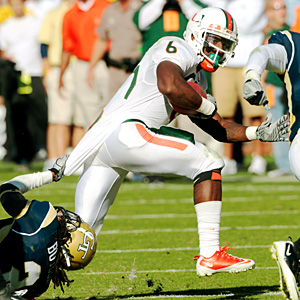
Out of reach? Maybe Justin Blackmon could land in Seattle...
“You’re always looking for touchdown makers on offense. You always want to get guys that can score. So if there’s a wide receiver in the draft that would be cool, if there’s a big- time running back that would be cool.”
– Pete Carroll, January 2012
The quote above raised a few eye-brows during Pete Carroll’s end of season press conference. The Seahawks have some talent at both skill positions, even if Marshaw Lynch is a free agent and a strong candidate for the franchise tag. When the subject of drafting a receiver in round one has been brought up on this blog, some have been quick to point to the existing talent on the roster. Sidney Rice, Doug Baldwin, Mike Williams, Golden Tate, Ben Obamanu and Deon Butler are flanked by highly regarded developing pro’s Kris Durham and Ricardo Lockette. The Seahawks also have depth at the tight end position, spending big bucks on Zach Miller and using Anthony McCoy and Cameron Morrah quite heavily. John Carlson is a free agent, but Carroll has already voiced his desire to agree terms on a new deal.
There’s a lot to work with there, but so far there isn’t one game-breaking talent. A ‘touchdown maker’ as Carroll puts it. In an injury-hit five-year career, Sidney Rice has just twenty touchdowns. In 2009 – his best season – he recorded a respectable but not overwhelming eight with Brett Favre rolling back the years and leading Minnesota to the NFC Championship game. Baldwin, Williams, Tate, Obomanu, Durham and Lockette have a combined total of twenty career touchdowns between them. Nobody would argue that there’s a lack of potential among the group, but there’s certainly room for a big-time playmaker. A touchdown maker.
I’m a fan of Justin Blackmon, Kendall Wright and Dwight Jones – the three best receivers in this group in my eyes. Yet I can also see a situation where not a single one goes in the top ten. Last year included two unique, rare players who combined size, speed, fluidity and an ability to contribute quickly. A.J. Green may go on to become the best receiver in the league even in Cincinnati. Julio Jones has the physical potential to be one of the most dangerous players in the league for Atlanta. Blackmon, Wright and Jones aren’t close to that level of potential, so it’s no lock they’ll go quite as early. Last year Blackmon wasn’t considered a likely top-15 pick while Wright and Jones weren’t in the first round discussion at all.
For the purpose of this article I’m going to concentrate on Blackmon because I wouldn’t rule out the Oklahoma State receiver being an option for the Seahawks. He’s 6-1 and around 211lbs – which isn’t a negative, but it’s not elite size – and he compares physically to the only other two-time Biletnikoff winner Michael Crabtree, but he’s a little more nimble and agile – yet lacks Crabtree’s near-flawless hands. I like his attitude on the field – he’s got that ‘alpha-male’ swagger to his play and truly believes he’s going to have a big impact on every game he features. He’ll compete with defensive backs, he’ll finish runs, he’ll chip away when blocking and get under your skin. Blackmon is possibly the most controlled receiver I’ve ever scouted, with supreme positioning and balance. He makes catches purely by doing the basics right and getting into the correct position on his routes. He’ll come into the league and cause problems with his double move which to create downfield problems and make up for a lack of truly elite deep speed and explosion out of his cuts. He has a natural feel for soft zones and will adapt his routes on developing plays to help out the quarterback.
The biggest knock on Blackmon is that in each game there seems to be at least one mental mistake – either a sloppy drop, lack of concentration or bizarre error. Overall he’s a very technically gifted receiver, but he’s not the physical freak of nature that has often guaranteed a high pick. He’s featured in an offense that notoriously favors the passing game and has consistently exploited talented receivers with big production. Blackmon was also arrested andcharged with DUI 2010 leading to a one-game suspension. There’s a lot to like here, but there’s also enough reasons to believe a slight fall into that #8-12 range isn’t beyond the realms of possibility.
In the five drafts before last April, only four receivers were taken in the top-15 picks. I like to call this the ‘Matt Millen effect’. During his time as GM in Detroit, Millen did more to create a stigma around drafting of receivers early in round one. He busted on Charles Rogers and Mike Williams, added Roy Williams with an early pick and went back again to draft Calvin Johnson before getting fired. Ironically, he finally got it right with Megatron – even if it was a no-brainer decision and too little, too late. The failure of Braylon Edwards, Troy Williamson and Mike Williams in 2005 maybe played some part too, but only Johnson, Ted Ginn Jr, Darius Heyward-Bey and Michael Crabtree became top-15 picks between 2006-2010. Fans – and more importantly teams – often refer to the high bust rate among the position, exemplified by an article from John McTigue for ESPN where he writes:
“With teams passing more and using more three-wide receiver sets, the perception has become that drafting a first-round talent at wide receiver is a necessity. However, despite the increase in pass plays and three-wide receiver formations, wide receivers haven’t been targeted more. Pass-catching tight ends and running backs are still just as important in offenses. As teams use more platoons at running back and as tight ends become more athletic, that is not likely to change.
“The sheer volume of wide receivers in the draft gives teams plenty of opportunities to get a high-caliber player. On a per game basis, first-round receivers since 2001 have averaged 3.4 receptions, 48.0 yards and 0.3 touchdowns. Receivers drafted in the secondround or later have averaged 2.1 receptions, 27.5 yards and0.2 touchdowns per game. (Those numbers were compiled from the 235 wide receivers who played at least one game.) When thinking of the difference between a first-round receiver anda second-round-or-later receiver, one 20-yard catch per game probably isn’t what comes to mind, but players like Greg Jennings, Chad Ochocinco, Vincent Jackson, Anquan Boldin, Brandon Marshall and Mike Wallace (among others) have helped close that gap.”
Of the top-ten receivers for yardage in 2011 – only three were former first round picks (Calvin Johnson #1, Larry Fitzgerald #4 and Roddy White #8). We can’t use the past to dictate what might happen this April, but clearly teams are being a little more cautious with the position. Considering the depth available this year at receiver – who’s to say that won’t happen again?
I don’t expect Justin Blackmon to go 2nd overall to St. Louis. While the Rams clearly need a productive receiver, it’ll be very difficult to pass on Matt Kalil. Jeff Fisher built a strong offensive line in Tennessee but he’s inheriting a porous line with really only one building block in Roger Saffold (maybe Jason Brown too, but he’s been a free-agent flop so far). Kalil is one of those players who will come into the league and quickly become one of the best at his position. He’s a slightly different player to Joe Thomas, but he could have a similar impact. The depth at receiver will afford the Rams an opportunity to address the position later and hey – Jeff Fisher can’t solve every problem in year one. The Rams simply cannot afford to pass on Kalil and chase other needs.
After St. Louis, there’s a series of team’s that could be interested in drafting a receiver. Minnesota relied too much on Percy Harvin last year, but also have huge holes on their own offensive line and in the secondary. Cleveland needs offensive playmakers, but shouldn’t pass on the opportunity to draft one of Robert Griffin III or Trent Richardson. Washington could look at the position, but are more likely to address quarterback and the offensive line as greater priorities. Jacksonville will surely look to help Blaine Gabbert and Pro-Football Weekly speculated this week that GM Gene Smith would aggressively pursue prospective free-agents such as Vincent Jackson. If they land a big name before the draft, it decreases the likelihood they’d spend big on the position in the draft with many other needs requiring aid. Carolina needs to build up a bad defense and Buffalo should re-sign Stevie Johnson and continue to add to both lines. That said – would anyone be surprised if any of these teams drafted Blackmon? Of course not, but at least there’s some rhyme or reason to the idea he could drop to an attainable range for Seattle.
Tony Pauline reported last week that some team’s graded Kendall Wright as the #1, not Blackmon. Given the depth of talent at receiver, there could be several ranking variations across the league. To come back to the Crabtree comparison – he was clearly regarded as the #1 receiver in 2009 but still went behind speed-merchant Darius Heyward-Bey. Of course, Crabtree received a negative press going into the draft and suffered a broken foot which forced him out of the combine and subsequent work-outs. Wright is a better, more rounded player than Heyward-Bey, but teams love a player who can take the top off a defense.
A lot of people will be sceptical of Blackmon dropping, or any of the other ‘big names’ for that matter – yet it does tend to happen every year. Twelve months ago Nick Fairley was the hot-tip to be the #1 overall pick and he eventually left the board at #13. Not many people expected Blaine Gabbert to fall as far as #10. Crabtree and Michael Oher are other good examples in recent times of big name prospects suffering a bit of a fall. Dropping to the #11 or #12 pick isn’t exactly a substantial act, so as we approach the Senior Bowl it’s worth thinking about players who might be available for Seattle that maybe we haven’t considered so far.
If Blackmon is there for the Seahawks, why wouldn’t they consider him? Even if you don’t see receiver as a critical need – this could be good value. John Schneider contributed to a system in Green Bay with real depth and quality at receiver and having a lot of talent at the position could help emulate that success in Seattle. If, of course, they can also upgrade the quarterback position. That’s a pretty big ‘if‘.
I’ve logged four game’s below, featuring Blackmon’s performances against Stanford, Texas Tech, Kansas State and Texas A&M.




































